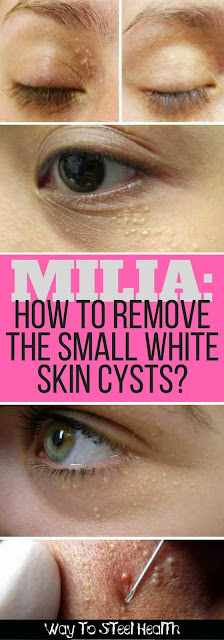What is Milia?
Those white or yellowish bumps you discovered are keratin-filled cysts that form just under the skin. They occur when dead skin cells get trapped.
 |
| Credit:waytosteelhealth.org |
However, it’s not that easy to get rid of milia.
Learning how to do it right is paramount. Especially if you have sensitive skin, you don’t want to damage your skin with poor milia removal techniques. If it doesn’t bother you appearance wise—best to leave it alone. Occasionally, they can dissolve on their own.
What Causes Milia?
There are several factors that cause milia in adults. Most commonly, they occur due to dead skin building up and getting trapped in the pores near the surface of the skin. If it doesn’t get expelled naturally, it can become small cysts. This type of milia is called Primary Milia.
The other type of milia is Secondary Milia. Primary and secondary milia look the same but develop from very different reasons. Secondary Milia happens when something clogs the sweat ducts. This usually is caused from some kind of skin trauma or infection, such as blistering, laser treatments, chemical peels, and herpes.
Other possible contributing lifestyle factors include: lack of sleep; smoking; poor personal hygiene; using oil-based beauty products in excess; and long-term steroid use.
How to Remove Milia at Home
Although tempting, if those pesky white bumps are near your eyes—either on the lids or under-eye skin—don’t remove it on your own. If it’s not in a sensitive area, such as your forehead or cheek, there are a few simple techniques to remove it safely.
But first, know that milia are not like a pimple that appears and goes away in a few days.
They don’t usually go away on their own. And you can’t pop it like you would a pimple. Milia removal usually requires an incision. The cysts are usually deep below the skin’s surface. Again, getting a milium isn’t harmful. But it is more than understandable if you want to remove it for aesthetic purposes.
Here are the seven highly effective steps to safely removing milia at home:
- Sanitize a sharp needle (the finer point the better) and tweezers or comedone extractor.
- Clean your face with gentle cleanser and rinse it thoroughly.
- Dry your face completely with a clean towel.
- Gently make a tiny incision on the top or on the side of the milium sufficient enough to excise it.
- Using the tweezers or extractor, apply gentle pressure to remove the milium up and out of the small opening.
- Apply an antiseptic or rubbing alcohol to the incision.
- When finished, continue with your regular skincare routine.
Again, milia aren’t like pimples. There isn’t more to extract by simply squeezing harder or repeatedly. Don’t continue to squeeze the area after the white bead has been removed. This will only cause damage.
Other Removal Solutions
If doing a mini-surgery on yourself makes you weak in the knees, there are other less invasive—albeit less immediate—methods. Here’s just a few:
Exfoliating Scrub
A gentle and regular exfoliation treatment can help to keep your skin free of the buildup that can clog pores and cause milia. There’s also evidence that some exfoliating compounds – like salicylic acid, citric acid, or glycolic acid – may keep keratin from being overproducedin your skin. But don’t exfoliate every day, it’s far too irritating.
Manuka Honey
Manuka Honey is a potent, and natural, antimicrobial that’s been shown to help in reducing irritation, so a honey mask is a great idea for milia. To apply a Manuka honey mask, zap the honey in the microwave for around 30 seconds first, so that the honey can be more easily applied to the face. Leave on for 10 minutes and rinse.
Apple Cider Vinegar
Apple cider vinegar is a natural astringent and is often used in place of a toner as it causes your pores to contract. This can help to keep your pores free of the debris that causes them to clog. Dilute ACV with water before applying to the face and use as either a cleanser or toner. And, here’s an interesting fact: it’s also a beauty secret of actress Scarlett Johansson
Retinoid Cream
Some studies recommend retinoid creams to banish milia. Retinoid is a form of vitamin A but should be used sparingly – just once a day is recommended. And, you should always wear sunscreen when using products containing retinoids, as your skin is more vulnerable to UV sun exposure.
These home remedies probably won’t work instantly. But with continuous use, these milia treatments may reduce or prevent them.
0 comments so far,add yours